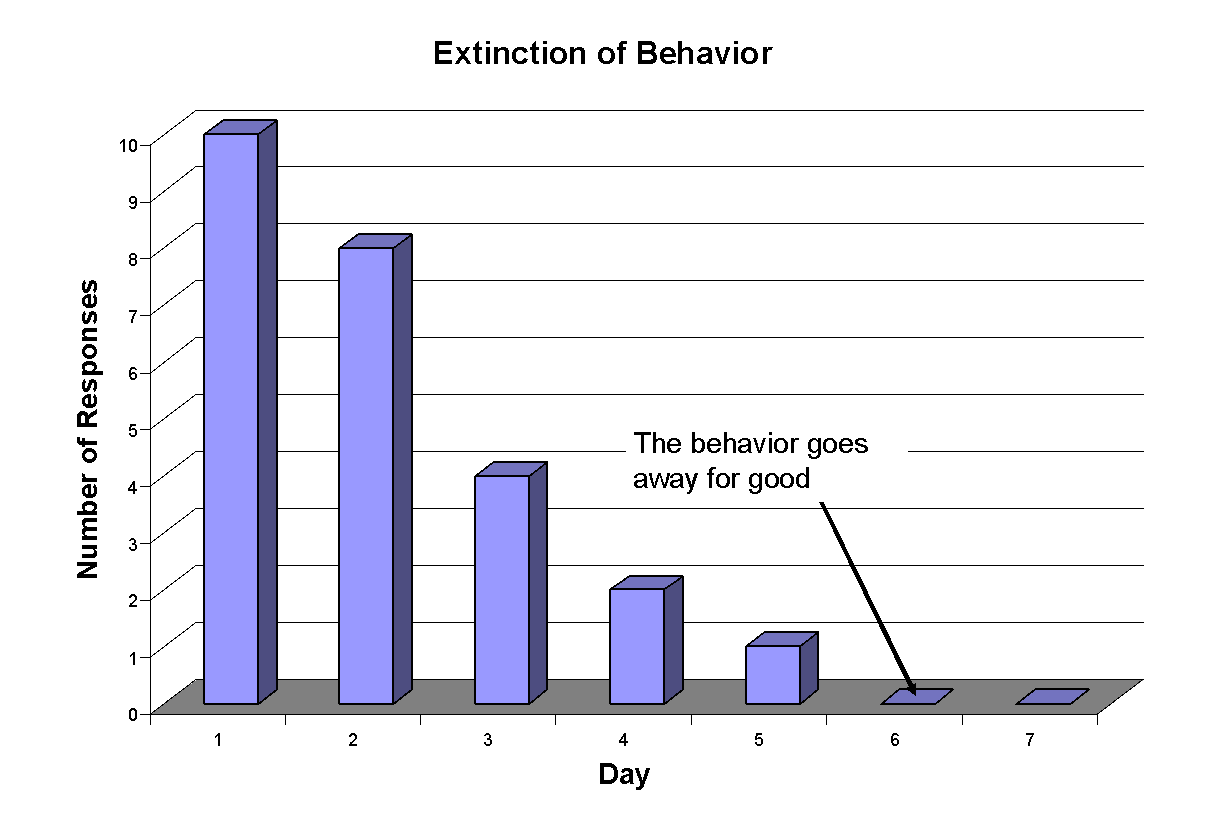When the characteristic consequence doesn’t follow behavior, the behavior will eventually stop. When this happens it is called extinction.
After behavior goes away following extinction, it usually comes back. When this happens, we call it spontaneous recovery.
Even though the behavior returns, you won’t get the same amount of behavior that occurred the last time. Instead, expect less of the behavior. If you continue withholding the desirable consequence a second time, the behavior will stop sooner than before; a third time, sooner before that.
When the behavior is useful at getting pleasant things or avoiding unpleasant things you should expect to see a lot of the behavior. In some cases, the behavior might level off at a certain rate (not increase or decrease in frequency), say it occurs about six or seven times on any given day. In some cases, when the behavior is very useful in getting pleasant things or avoiding unpleasant things you might actually see the rate of behavior increase over time.
As long as the behavior is effective, it won’t go away. If, however, the characteristic consequence doesn’t follow behavior, the behavior will eventually stop. When this happens it is called extinction.
You can “see” extinction everywhere if you look for it. Let us consider several examples. If you call a person and neither the person picks up or never returns your calls, you will stop calling at some point (unless you’re the type of individual who requires a restraining order to back off!). Your calling behavior undergoes extinction. If your favorite restaurant comes under new ownership, and they consistently serve you a bland meal, you will stop going there. Your going to that particular restaurant undergoes extinction. Ignoring, when done effectively, does the same thing. When someone is doing something annoying (to you) to get your attention, if you pay no attention to it and wait it out, the person will eventually stop. His or her annoying behavior undergoes extinction. Of course, we have to assume that the behavior is attention-maintained, were it to undergo extinction if you withhold it long enough.
You might recommend to staff to distract a patient – when they are asking the same question(s) over and over – and transition the patient to a preferred activity or topic. Of course, one has to know the patient well in order to know what that preferred activity or topic is.
When you withhold the desirable consequence, three things usually happen. One, behavior usually goes way up in frequency. Simply, you see more of the behavior. Two, the behavior becomes more intense. If a person calls out your name, and you ignore him or her, the individual will likely speak louder. (Interestingly, when an individual speaks another language, English speakers often raise their voices, as their verbal behavior goes on extinction). Three, the person becomes emotional, sometimes angry, sometimes sad – most often what we call “frustrated.” All three of these occurrences make up what’s called an extinction burst – like a burst of sudden energy. You see extinction bursts while driving, when you’re stuck behind slow moving traffic and the lane opens up. Almost invariably, you drive a little faster, more aggressively.
After behavior goes away following extinction, it usually comes back. When this happens, we call it spontaneous recovery. While not on the same day, the problem behavior may return the next day or the day after that. Of course, in some cases the behavior might return within hours. We really have no way of knowing beforehand.
Even though the behavior returns, you won’t get the same amount of behavior that occurred the last time. Instead, expect less of the behavior. If you continue withholding the desirable consequence a second time, the behavior will stop sooner than before; a third time, sooner before that.
A day or two later, you might see the behavior a fourth time, though less of it than before. If you continue blocking the desired, pleasant consequence, it will go away a lot faster than the last time, and so on. After returning and going away, and returning and going away, eventually the behavior will stop entirely – it won’t come back. Simply, the person stops the behavior because there is no purpose in doing it anymore.
Below, is a graph showing you the process of extinction. The height of the bar indicates the number of responses. Taller bars mean more responses. Shorter bars mean fewer responses. Each bar represents a different day.

Copyright © 2020 Kyle Ferguson, Ph.D.
